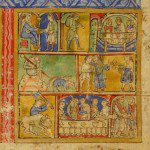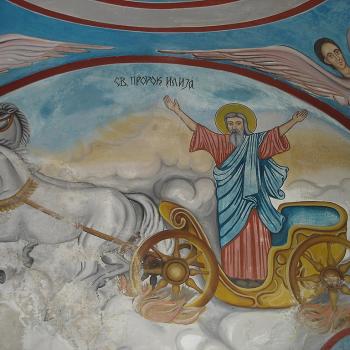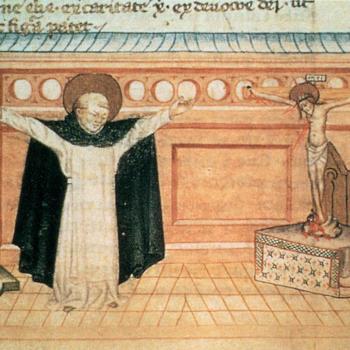![Jesus Christ from Hagia Sophia. Photograph by Edal Anton Lefterov (Own work) [CC BY-SA 3.0 (http://creativecommons.org/licenses/by-sa/3.0)], via Wikimedia Commons](https://wp-media.patheos.com/blogs/sites/637/2017/02/Jesus-Christ-from-Hagia-Sophia-262x300.jpg)
Another purpose for Scripture is to reveal the history of humanity working and struggling with God. From its stories, we learn what it means to wrestle with God, both in the way humans struggle against the wishes of God, but also, what it is like to have God by our side as we fight against the fallen spiritual powers which dominate the world and try to keep it separate from union with God. We see in it God interacting with humanity, leading humanity to some great goal. We also see many instances of God willingly make room for humanity, to let humanity make its own destiny and become whatever it would like to make of itself. We see in it the power of God which is established through his love as well as the grace God is willing to extend to humanity through his providence.
If we read Scripture as representing history, we must be careful and not assume it to be history in the modern, positivistic sense, but in the mythic sense, revealing the developing self-awareness of the People of God. It is in this light it is understandable that opinions and beliefs will change and develop, and so within the text, apparent contradictions will be seen. The contradictions only qualify as such if Scripture is understood purely as the letter and all that is in it is to be interpreted following the most unsophisticated and hyper-literal form possible, and every text, in and of the letter of the text, is believed to have equal value and authority. There is an internal cohesion which unifies the text, transcending the particulars but seen through them, just as our beliefs and practices in our youth will look superficial and contradictory to what we believe and understand as adults, and yet they are part of the stages which lead to our adulthood and what we believe to this day is connected to what we believed before.
Likewise, Scripture is also intended to help guide us in our lives, to grant us wisdom which we can use to help us act prudentially in our daily activities. Prudence is necessary, and Scripture provides the means by which we can receive that prudence, for provides the examples and moral foundations by which we can establish principles for today. Here, again, an overly literal understanding would be a problem, for it would lead to the kind of legalism which turns guidelines into absolutes, not understanding the difference between the two, and so overburdening the reader with a collection of laws which no one could fulfill. The fact that when the text is read in a legalistic manner, it becomes difficult to understand how and why the same actions can be approved and condemned in Scripture, should demonstrate that such a simplistic reading is not intended of the text. As Origen and many others have indicated, such apparent self-contradictions on the surface level should be evidence enough that the text is to be read in a different manner, if the text is to be properly understood.
Finally, Scripture reveals how we are to be saved, but also, what happens after, our union with God. To discern what the text indicates is necessary for salvation requires more than reading one or another verse talking about salvation, but to read them all together, to see what they establish when brought together as one whole, lest we end up ignoring various expectations Scripture gave us for our salvation.
While not a conclusive list, these purposes serve as the basic foundations for a Christian theological engagement with Scripture. Certainly, in our exploration, we can engage the texts with various critical methods. We can examine the texts within it with historical-critical eyes, looking at Scripture like an archeologist, seeing differences of opinions and theological understanding over time; we can see how texts were written and edited together by a later redactor who sometimes radically modified the text, and find things of interest which emerge as we see anew the past, but like Tolkien with Beowulf, we must understand the core interest must remain as how the church has brought the text together, edited together through the centuries, modifying it until it fit the icon it wanted to make, and engage that core, finalized text as our point of entry.[1] Realizing the history of how it came to be written and brought together as one final text does not discount the authority of that final form, just as it does not undermine the final form Beowulf has taken as being the authoritative form of the text. To try to discount its finished form because of the tinkering which went in to its production would be like discounting the final, printed form of any text which has undergone a series of drafts before a final, polished form is used for publication. As a good story-teller, the church collected a variety of texts to present its intended meaning, engaging what had been rendered to it while purifying and polishing it to its own desired end.
[1] Tolkien, in his seminal speech and essay, “Beowulf: The Monster and the Critics,” was concerned with the kind of scholarship which had followed Beowulf; such scholarship tended to be interested in everything but the poem itself. He presented in it an allegory of the problem in which a house is made from old stones, but the house is not the same in its history and purpose as those old stones from which it was made:
I would express the whole industry in yet another allegory. A man inherited a field in which was an accumulation of old stone, part of an older hall. Of the old stone some had already been used in building the house in which he actually lived, not far from the old house of his fathers. Of the rest he took some and built a tower. But his friends coming perceived at once (without troubling to climb the steps) that these stones had formerly belonged to a more ancient building. So they pushed the tower over, with no little labour, in order to look for hidden carvings and inscriptions, or to discover whence the man’s distant forefathers had obtained their building material. Some suspecting a deposit of coal under the soil began to dig for it, and forgot even the stones. They all said: ‘This tower is most interesting.’ But they also said (after pushing it over): ‘What a muddle it is in!’ And even the man’s own descendants, who might have been expected to consider what he had been about, were heard to murmur: ‘He is such an odd fellow! Imagine his using these old stones just to build a nonsensical tower! Why did not he restore the old house? He had no sense of proportion.’ But from the top of that tower the man had been able to look out upon the sea.
J.R.R. Tolkien, “Beowulf: The Monster and the Critics” in The Monster & The Critics and Other Essays. ed. Christophe Tolkien (London: Harper Collins, 1997), 7-8.
Scholars interested only in the building blocks might note how the house uses stones for different purposes than they were used before, and so will ask the house to be reformed to meet the original use of those stones, ignoring the reason for the changes and the good of the new house itself. This served as a foundation for Tolkien’s desire to revolutionize Beowulf scholarship, to have more focus on the poem itself, and what it does in its own merit, and likewise, serves as an example of how other compiled texts should be examined. Yes, the parts can be of interest, but when brought together as a whole, the parts can be changed, and to look at them from their early use will fail to ignore those changes and what they establish in the new context.
Stay in touch! Like A Little Bit of Nothing on Facebook:
A Little Bit of Nothing













